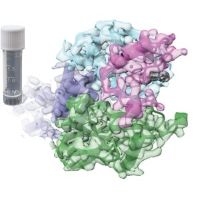Specification
| Description | Recombinant protein from the full-length sequence of Homo sapiens THAP domain containing 1 (THAP1), transcript variant 1 (NM_018105). |
| Organism | Homo sapiens (Human) |
| Expression Host | Human Cells |
| Tag Info | His or DYKDDDDK. Please contact us if you need further information or require specific designed tag. |
| Purity | Greater than 90% by SDS-PAGE gel |
| Uniprot ID | Q9NVV9 |
| Entry Name | THAP1_HUMAN |
| Gene Names | THAP1 |
| Alternative Gene Names | |
| Alternative Protein Names | THAP domain-containing protein 1 |
| Application | Antigens, Western, ELISA and other in vitro binding or in vivo functional assays, and protein-protein interaction studies; For research & development use only! |
| Buffer | Purified protein formulated in a sterile solution of PBS buffer, pH7.2, without any preservatives |
| Endotoxin | Endotoxin level is < 0.1 ng/µg of protein (<1EU /µg) |
| Length | 213 |
| Molecular Weight(Da) | 24944 |
| Protein Sequence | (The sequence of expressed protein may have some variation from the sequence shown below. Please contact us for the exact sequence.) MVQSCSAYGCKNRYDKDKPVSFHKFPLTRPSLCKEWEAAVRRKNFKPTKYSSICSEHFTPDCFKRECNNKLLKENAVPTIFLCTEPHDKKEDLLEPQEQLPPPPLPPPVSQVDAAIGLLMPPLQTPVNLSVFCDHNYTVEDTMHQRKRIHQLEQQVEKLRKKLKTAQQRCRRQERQLEKLKEVVHFQKEKDDVSERGYVILPNDYFEIVEVPA |
Background
| Function | FUNCTION: DNA-binding transcription regulator that regulates endothelial cell proliferation and G1/S cell-cycle progression. Specifically binds the 5'-[AT]NTNN[GT]GGCA[AGT]-3' core DNA sequence and acts by modulating expression of pRB-E2F cell-cycle target genes, including RRM1. Component of a THAP1/THAP3-HCFC1-OGT complex that is required for the regulation of the transcriptional activity of RRM1. May also have pro-apoptotic activity by potentiating both serum-withdrawal and TNF-induced apoptosis. {ECO:0000269|PubMed:12717420, ECO:0000269|PubMed:17003378, ECO:0000269|PubMed:20200153}. |
| Pathway | |
| Protein Families | THAP1 family |
| Tissue Specificity | Highly expressed in heart, skeletal muscle, kidney and liver. Weaker expression in brain and placenta. {ECO:0000269|PubMed:20200153}. |
QC Data
| Note | Please contact us for QC Data |
| Product Image (Reference Only) |  |

